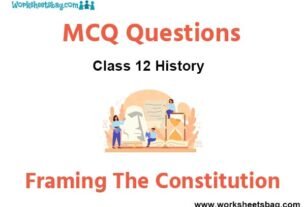Please refer to Polymers MCQ Questions Class 12 Chemistry below. These MCQ questions for Class 12 Chemistry with answers have been designed as per the latest NCERT, CBSE books, and syllabus issued for the current academic year. These objective questions for Polymers will help you to prepare for the exams and get more marks.
Polymers MCQ Questions Class 12 Chemistry
Please see solved MCQ Questions for Polymers in Class 12 Chemistry. All questions and answers have been prepared by expert faculty of standard 12 based on the latest examination guidelines.
MCQ Questions Class 12 Chemistry Polymers
Question. PVC polymer can be prepared by which of the monomer?
(a) CH3CH = CH2
(b) C6H5CH = CH2
(c) CH2 =CH2
(d) CH2 =CH—Cl
Answer
D
Question. Which one of the following is not a correct match?

(a) Teflon Tetrafluoroethylene
(b) Plexi glass Methyl methacrylate
(c) Orlon Glycerol, phthalic anhydride
(d) Buna-S Styrene, 1,3-butadiene
Answer
C
Question. Which of the following is currently used as a tyre cord?
(a) Polyethylene
(b) Polypropylene
(c) Bakelite
(d) Nylon-6
Answer
D
Question. Which of the following is fully fluorinated polymer?
(a) PVC
(b) Thiokol
(c) Teflon
(d) Neoprene
Answer
C
Question. Which of the following is cross-linked polymer?
(a) Teflon
(b) Orlon
(c) Nylon
(d) Bakelite
Answer
D
Question. Which one is classified as a condensation polymer?
(a) Dacron
(b) Neoprene
(c) Teflon
(d) Acrylonitrile
Answer
A
Question. A copolymer of ethene and vinyl chloride contains alternate monomers of each type. What is the mass percentage of vinyl chloride in this copolymer?
(a) 38%
(b) 69%
(c) 72%
(d) 82%
Answer
B
Question. Which type of polymer is bakelite?
(a) Addition polymer
(b) Homopolymer
(c) Condensation polymer
(d) Biopolymer
Answer
C
Question. Which of the following is a biodegradable polymer?
(a) Cellulose
(b) PVC
(c) Nylon-6
(d) Polythene
Answer
A
Question. Which of the following is biodegradable polymer?
(a) Polythene
(b) Bakelite
(c) PHBV
(d) PVC
Answer
C
Question. Cellulose, protein and starch are classified as
(a) natural polymers
(b) aldehydes
(c) esters
(d) synthetic polymers
Answer
A
Question. Which of the following has an ester linkage?
(a) Nylon-6,6
(b) Dacron
(c) PVC
(d) Bakelite
Answer
B
Question. Terylene is not a
(a) copolymer
(b) polyester fibre
(c) chain growth polymer
(d) step growth polymer
Answer
C
Question. Which one of the following is a copolymer?
(a) Saran
(b) Orlon
(c) PVC
(d) Teflon
Answer
A
Question. The polymer containing strong intermolecular forces, i.e. hydrogen bonding, is
(a) teflon
(b) nylon-6,6
(c) polystyrene
(d) natural rubber
Answer
B
Question. Polycondensation products of dicarboxylic acids and diols are
(a) polyamides
(b) neoprene
(c) glyptal
(d) polyesters
Answer
D
Question. PDI for natural polymers is generally close to
(a) 0
(b) 1
(c) 10
(d) 100
Answer
B
Question. The most suitable property determination of polymers is for molecular weight
(a) osmotic pressure
(b) lowering of vapour pressure
(c) elevation in boiling point
(d) depression in freezing point
Answer
A
Question. Which one of the following is not a condensation polymer?
(a) Nylon-6, 6
(b) Nylon-6
(c) Dacron
(d) Buna-S
Answer
D
Question. Which one of the following is the structure of polyacrylonitrile?

Answer
B
Question. Which of the following alkenes is most reactive towards cationic polymerisation?
(a) CH2 = CHCH3
(b) H2C = CHCI
(c) H2C = CHC6H5
(d) H2C = CHCO2CH3
Answer
C
Question. Which of the following is not a polymer?
(a) Teflon
(b) Petroleum
(c) Cellulose
(d) Natural rubber
Answer
B
Question. Which one of the following is a chain growth polymer?
(a) Starch
(b) Nucleic acid
(c) Polystyrene
(d) Protein
Answer
C
Question. In the reaction sequence,

X is
(a) cyclohexanone
(b) caprolactam
(c) HO (CH2)6NH2
(d) hexamethylene cliisocyanate
Answer
B
Question. Catalyst used in dimerisation of acetylene to prepare chloroprene is
(a) HgSO4 + H2SO4
(b) Cu2Cl2
(c) Cu2Cl2 + NH4Cl
(d) Cu2Cl2 + NH4OH
Answer
C
Question. The plastic household crockery is prepared by using
(a) melamine and tetrafluoroethane
(b) malonic acid and hexamethylenediamine
(c) melamine and vinyl acetate
(d) melamine and formaldehyde
Answer
D
Question. Nylon-6,6 is not a
(a) condensation polymer
(b) polyarnide
(c) Both (a) and (b)
(d) None of these
Answer
D
Question. Synthetic polymer which resembles natural rubber is
(a) neoprene
(b) chloroprene
(c) glyptal
(d) nylon
Answer
A
Question. Three dimensional molecules with cross-links are formed in the case of a
(a) thermoplastic
(b) thermosetting polymers
(c) Both (a) and
(b) (d) None of these
Answer
B
Question. An example of natural biopolymer is
(a) teflon
(b) nylon-6,6
(c) rubber
(d) DNA
Answer
D
Question. Rayon is
(a) natural silk
(b) artificial silk
(c) regenerated fibre
(d) synthetic fibre
Answer
C
Question. In case of condensation polymers,
(a) high molecular weight polymers are formed all at once
(b) lower molecular weight polymers are formed all at once
(c) molecular weight of polymer rises throughout the reaction
(d) have no specific relation to their molecular weights
Answer
C
Question. Which of the following is a condensation polymer?

(b) Rubber
(c) Polyvinyl chloride
(d) Polyethylene
Answer
A
Question. Bakelite is a product of the reaction between
(a) formaldehyde and NaOH
(b) aniline and urea
(c) phenol and methanal
(d) phenol and chloroform
Answer
C
Question. Nylon threads are made of
(a) polyvinyl polymer
(b) polyester polymer
(c) polyamide polymer
(d) polyethylene polymer
Answer
C
Question. Identify the copolymer from the following.

Answer
A
Question. The process of formation of polymers from respective monomers is called
(a) polyacrylonitrile
(b) copolymerisation
(c) polymerisation
(d) None of these
Answer
C
Question. Which one is chaingrowth polymer?
(a) Teflon
(b) Nylon-6
(c) Nylon-6,6
(d) Bakelite
Answer
A
Question. Which type of polymer is cellulose diacetate fibre?
(a) Synthetic
(b) Natural
(c) Semi-synthetic
(d) None of these
Answer
C
Question. Dacron is a polymer of
(a) ethylene glycol and formaldehyde
(b) ethylene glycol and phenol
(c) ethylene glycol and phthalic acid
(d) ethylene glycol and terephthalic acid
Answer
D
Question. The polymer polyurethanes are formed by treatmg diisocyanate with
(a) butadiene
(b) isoprene
(c) glycol
(d) acrylonitrile
Answer
C
Question. Which one of the following is a condensation polymer?
(a) Rubber
(b) Protein
(c) PVC
(d) Polythene
Answer
B
Question. Match Column I with Column II and select the correct answer using the codes given below.

A B C D
(a) 2 1 4 5
(b) 3 4 1 2
(c) 4 3 2 1
(d) 5 3 1 2
(e) 5 3 2 1
Answer
E
Question. Given the polymers, A= nylon-6, 6, B = buna-S, C = polythene. Anange these in increasing order of their intermolecular force (lower to higher).
(a) A < B < C
(b) A < C < B
(c) B < C < A
(d) C < A < B
Answer
C
Question. If Mw is the weight average molecular weight and Mn. is the number average molecular weight of a polymer, the polydispersity index (PDI) of the polymer is given by

Answer
B
Question. The number average molecular mass and mass average molecular mass of a polymer are respectively 30,000 and 40,000. The polydispersity index of the polymer is
(a) < 1
(b) > 1
(c) 1
(d) 0
(e) -1
Answer
B
Question. Novolac, the linear polymer used in paints is
(a) copolymer of 1, 3-butadiene and styrene
(b) obtained by the polymerisation of methyl methacrylate
(c) initial product obtained in the condensation of phenol and formaldehyde in the presence of acid catalyst
(d) obtained by the polymerisation of caprolactam
(e) copolymer of melamine and formaldehyde
Answer
C
Question. Bakelite is a
(a) urea formaldehyde resin
(b) phenol formaldehyde resin
(c) polyethylene
(d) artificial rubber
(e) polyvinyl chloride
Answer
B
Question. Which of the following is called polyamide?
(a) Terylene
(b) Rayon
(c) Nylon
(d) Orlon
Answer
C
Question. Natural rubber is not used in makmg footwears for polar regions because
(a) natural rubber becomes soft at temperature lower than 10°C
(b) natural rubber becomes brittle at temperature lower than 10°C
(c) natural rubber melts at temperature lower than 10°C
(d) natural rubber becomes stronger at temperature lower than 10°c
Answer
B
Question. Which of the following polymers turns yellowish on exposure to sunlight?
(a) Polystyrene
(c) Polyethylene
(b) Nylon
(d) Styrene butacliene resin
Answer
D
Question. What is incorrect regarding natural rubber?
(a) It is cis-polyisoprene
(b) It is amorphous in nature
(c) It has syndiotactic stereochemistry
(d) Molecules of rubber have coiled conformation
Answer
C
Question. Natural rubber is a polymer of
(a) styrene
(b) styrene and 1, 3-butadiene
(c) tetrafluoroethylene
(d) 2-methyl-l, 3-butadiene
(e) 3-methyl-l, 2-butadiene
Answer
D
Question. The monomers ofbuna-S rubber are
(a) vinyl chloride and sulphur
(b) butadiene
(c) styrene and butadiene
(d) isoprene and butadiene
Answer
C
Question. Which compound polymerises to neoprene?
(a) CH2= CHCl
(b) CH2=C·Cl—CH=CH2
(c) Cl2C=C·Cl2
(d) F2C=CF2
Answer
B
Question. F2C= CF2 is a monomer of
(a) teflon
(b) nylon
(c) glyptal
(d) buna-S
Answer
A
Question. Name of compound/compounds used in preparation of nylon-66.
(a) e-caprolactam
(b) hexamethylenediamine and adipic acid
(c) dimethyl terephthalate
(d) hexamethylene diamine
Answer
B
Question. Neoprene is a polymer of
(a) vinyl chloride
(b) propene
(c) isoprene
(d) chloroprene
Answer
D
Question. Which of the following compounds is used in the formation of nylon-6,6?
(a) Sulphur hexafluoride
(b) Aclipic acid
(c) Sulphurous acid
(d) Phthalic acid
Answer
B
Question. Mark out the most unlike form of polymerisation of

Answer
D
Question. Nylon-6,6 is an example of
(a) poly propylene
(b) polyester
(d) polystyrene
(c) polyamide
Answer
C
Question. Condensation product of caprolactam is
(a) nylon-6
(b) nylon-6,6
(c) nylon-60
(d) nylon-6, 10
Answer
A
Question. Which of the following is a monomer ofteflon?
(a) Difluoroethane
(b) Trifluoroethane
(c) Tetrafluoroethane
(d) None of the above
Answer
D


